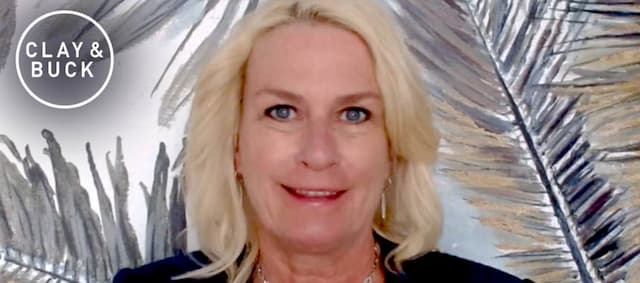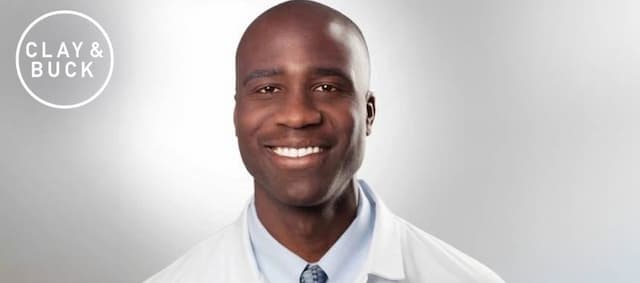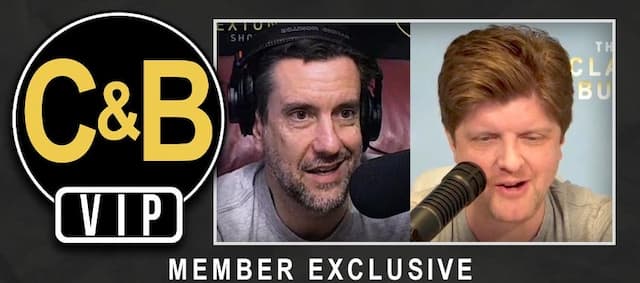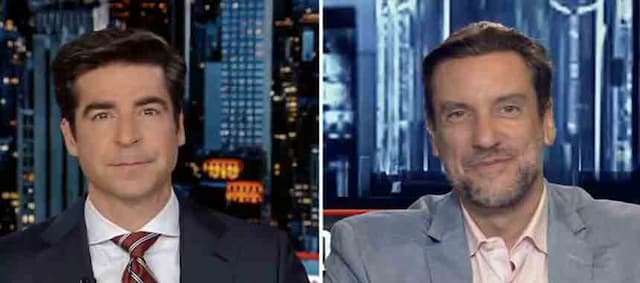Doug Blair Tells Us What He Saw at the SCOTUS Protests
BUCK: We’ve got Doug Blair with us now. He’s a news producer at the Daily Signal and co-host of the Daily Signal Podcast. Doug, thanks for being with us.
BLAIR: Hey, guys. Thanks so much for having me on.
BUCK: So, our understanding is you are out there watching some of these protests, you know, “Nice house you got there, Supreme Court justice,” kind of protest, you know what I mean?
BLAIR: Yes.
BUCK: People are worried about this, people are worried about the security, the safety of these justices. What did you see?
BLAIR: Yeah. No. You’re absolutely right. I was out there watching these protesters march around and find their way suddenly in front of the houses of some of the most important justices in the land. It was horrifying. These people are so angry, they’re so spiteful, and the fact that they thought it was appropriate for them to go to the houses — the private residences — of some of these justices, really for only one reason. It’s to intimidate this. It’s to force them to think that they’re in danger and if they don’t vote a certain way on Roe v. Wade, they’re gonna do something — and we don’t know what that something is, but it sure ain’t good.
A collection of signs from the march to Justice Alito’s house. pic.twitter.com/fE5FW8BDJC
— Douglas Blair (@DouglasKBlair) May 9, 2022
CLAY: Doug, what is the overall vibe of the crowd that you found yourself in outside of these homes? Did it feel dangerous? Did it feel potentially violent? How sustained do you get the sense that this is going to be? For those of us who haven’t been around these crowds, take us inside their midst and tell us what it felt like.
BLAIR: So, I’ve been to a couple of these protests right now, and it depends on which person it is. Justice John Roberts felt like your very average, like, “I’m mad; I’m gonna protest in front of somebody’s house who I don’t like,” which is ideally not what you’re doing, but this is where we’re at now with the modern left. They were upset but they weren’t that upset. I mean, it got so much worse.
When they got to Brett Kavanaugh’s house, something in the air just changed. You could feel it turn like a switch. They just viewed this person as, like, a monster, subhuman, and they wanted him to know that they were out there and they hated his guts. So I heard one protester yell and scream, “I can see you, Brett!” I hope to God he was wrong. I hope that Brett actual wasn’t at his house, Justice Kavanaugh wasn’t at his house. But it was terrifying. I was scared for the police officers who were there because this crowd was just so agitated and so angry.
BUCK: Doug, what was the security presence like? Were there police officers that were doing crowd control of these protesters? We were discussing earlier in the program that this would seem to be a violation of law in the state of Virginia, the state of Maryland respectively. But were there police on scene? And what was that like?
A male speaker comes up and talks about LGBT laws. “THIS IS GENOCIDE” screams a protestor. pic.twitter.com/gWsxu6WjeH
— Douglas Blair (@DouglasKBlair) May 10, 2022
BLAIR: Absolutely. So there were, thankfully, police on presence. There was a police presence at the houses. I think it’s accuse scary, though, the fact that there had to be a police presence at these places because it just shows you how far down the discourse in America has got where these protesters felt like the response to a decision that they may not like from the Supreme Court is to go and intimidate these justices. I think it’s just terrifying that we’ve reached this point where the left feels empowered to go and harass people where they live to try and get what they want — and thankfully there were police officers there. I shudder to think what would have happened if there weren’t.
CLAY: You know, Doug one of the things we were talking about and discussing is the challenges associated with enforcing these laws, whether it’s Maryland, whether it’s Virginia, whether it’s D.C., where some of these justices may live. What do you think would have happened based on being in that crowd if there had started to be arrests made? Does this make protests more likely going forward, does it make martyrs of the people who are arrested, or would that nip these protests in the bud and the people that you saw are unlikely to keep showing back up? How would you assess that aspect of these protests?
The crowd has started to chant “abort the court.” Others are screaming “F Alito!” pic.twitter.com/9Y9AHjZEKp
— Douglas Blair (@DouglasKBlair) May 10, 2022
BLAIR: It’s funny you ask me that, because I actually had a circumstance where I was watching these protests happen and the police showed up in full force. About five cop cars showed up outside of Justice Kavanaugh’s house, and you wouldn’t even believe it that there had been a hundred people there ’cause they scattered to the wind. They were terrified of the police coming to arrest them.
I think that they’re terrified overall, too, of this movement that’s happening right now, right? I think America is sort of seeing a revitalization of a culture of life that has been gone for 50 years since Roe v. Wade was formally put into place. I think that these protesters feel as if they’re seeing the demise of an abortion-type regime that has been existing in this country for far too long. And I think when they saw the cops show up, they recognized that, you know, time was not on their side anymore. They were going to lose this fight and that they didn’t want to be around to see what the results were gonna be.
BUCK: We’re speaking to Douglas Blair. He’s producer at the Daily Signal, co-host of the Daily Signal podcast. Doug, is the expectation that they’re just gonna be ongoing protests every day or are they gonna try to camp out somewhere in the neighborhood, Occupy style? What’s gonna happen based on what you’re hearing from people who were there and from the authorities who are trying to keep it relatively orderly?
BLAIR: It’s an excellent question because I don’t see these ending anytime soon. So there’s a planned protest for tomorrow they’re gonna go to all of the conservative justices’ houses. So far they’ve only done Alito, Roberts, and Kavanaugh. There’s plans for tomorrow to hit the rest of them. But I easily could see this going on for a long, long time.
The marchers are almost to Alito’s house. Very few police officers. pic.twitter.com/8yyXpHOuRQ
— Douglas Blair (@DouglasKBlair) May 10, 2022
This is not a group that gives up. Yesterday, I actually got some very concerning footage of Black Bloc and Antifa members who attended these protests. All of the other protests I had seen, they were angry people for sure, and they were definitely upset, and they did inappropriate things in front of the houses of these justices. But there was no Black Bloc present.
I’m from Portland, Oregon, so I know exactly what happens when ascent and Black Bloc show up to a protest. It gets real bad, real quick. So that was incredibly disturbing for me to see that these people were attending these protests. And I do want to note one thing very quickly. As we are starting to see these protests get more and more aggressive and more and more threatening to the lives, I think it’s despicable how we haven’t seen a response from the administration to this.
We saw a very lukewarm, very milquetoast statement come out from President Biden and Jen Psaki about how, “You know, violence is unacceptable in protesting.” Sure. That’s fine. But, like, I think we need actual condemnation of what is happening right now in these particular protests. It’s not acceptable for you to go to somebody’s house and threaten them and harass them to get the judgment that you want.
CLAY: Doug, last question here for you. You’re talking about the duration of these complaints and these protests. What sense do you get, if any, of the neighbors? Because I were living in these neighborhoods regardless of what my politics would be, I would be really, really angry about people taking over my neighborhood and chanting political slogans regardless of what they were, ’cause I’m trying to get my kids to Little League and I’m trying to get in and out of school. Did you get in you sense for the neighborhoods that these justices live in and what that response might be?
There is an Antifa and black bloc presence at the protest. pic.twitter.com/DRWfeeMagw
— Douglas Blair (@DouglasKBlair) May 9, 2022
BLAIR: Right. It’s funny you mention that because these are suburbs of Washington, D.C. Washington is clearly one of the most blue cities in the country and it’s very, very, very left-leaning. So sometimes the neighbors would come out and join the marches! We would see people who would come out of their houses; they would cheer, they would clap. As I mentioned some would begin to walk with the protesters.
One of the protesters in charge of the Kavanaugh protest was his neighbor. This was a person who thought that he was an evil person. And, again, I think that’s just so sad that we’re at this point in the country where your neighbor, somebody that you should at least have friendly terms with — or at least, you know, interact with — is deciding that the best way to deal with you is to go outside and to harass you where you live. It seems like that is just such a strange place for us to be right now. And the neighbors, the fact that they were joining in on it I think just really adds fuel to that fire that this is a completely inappropriate way to do it, that they were in on the game.
CLAY: Doug, appreciate the time, appreciate the work. We’ll continue to follow you and your coverage of these potential protests. Appreciate it, my man.
BLAIR: Absolutely. Thank you so much for having me.





